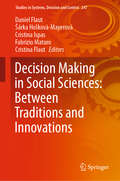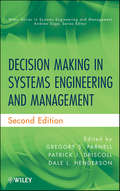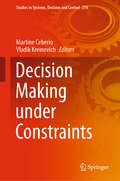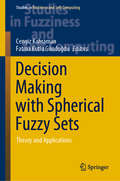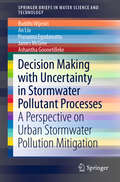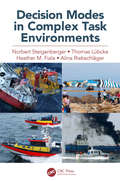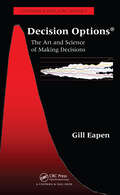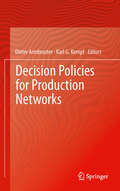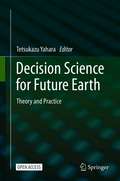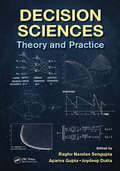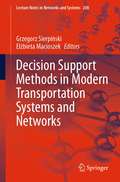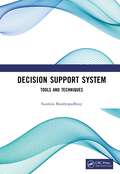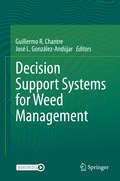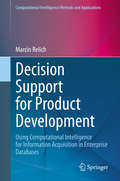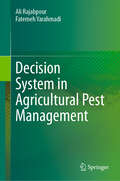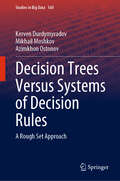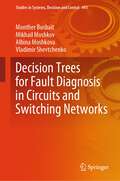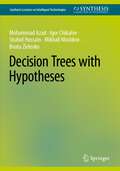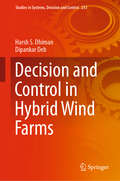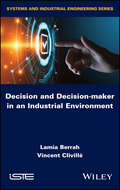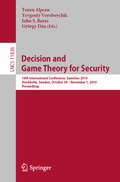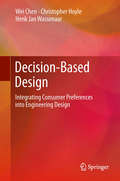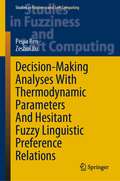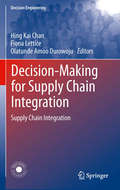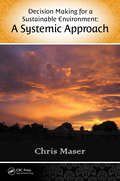- Table View
- List View
Decision Making in Social Sciences: Between Traditions and Innovations (Studies in Systems, Decision and Control #247)
by Šárka Hošková-Mayerová Fabrizio Maturo Cristina Flaut Daniel Flaut Cristina IspasThis book explores several branches of the social sciences and their perspectives regarding their relations with decision-making processes: computer science, education, linguistics, sociology, and management. The decision-making process in social contexts is based on the analysis of sound alternatives using evaluative criteria. Therefore, this process is one that can be rational or irrational, and can be based on knowledge and/or beliefs. A decision-making process always produces a final decision, which may or may not imply prompt action, and increases the chances of choosing the best possible alternative. The book is divided into four main parts. The concepts covered in the first part, on computer science, explore how the rise of algorithms and the growth in computing power over the years can influence decision-making processes. In the second part, some traditional and innovative ideas and methods used in education are presented: compulsory schooling, inclusive schools, higher education, etc. In turn, the third part focuses on linguistics aspects, and examines how progress is manifested in language. The fourth part, on sociology, explores how society can be influenced by social norms, human interactions, culture, and religion. Management, regarded as a science of the decision-making process, is explored in the last part of this book. Selected organizations’ strategies, objectives and resources are presented, e.g., human resources, financial resources, and technological resources. The book gathers and presents, in a concise format, a broad range of aspects regarding the decision-making process in social contexts, making it a valuable and unique resource for the scientific community.
Decision Making in Systems Engineering and Management
by Gregory S. Parnell Patrick J. Driscoll Dale L. HendersonDecision Making in Systems Engineering and Management is a comprehensive textbook that provides a logical process and analytical techniques for fact-based decision making for the most challenging systems problems. Grounded in systems thinking and based on sound systems engineering principles, the systems decisions process (SDP) leverages multiple objective decision analysis, multiple attribute value theory, and value-focused thinking to define the problem, measure stakeholder value, design creative solutions, explore the decision trade off space in the presence of uncertainty, and structure successful solution implementation. In addition to classical systems engineering problems, this approach has been successfully applied to a wide range of challenges including personnel recruiting, retention, and management; strategic policy analysis; facilities design and management; resource allocation; information assurance; security systems design; and other settings whose structure can be conceptualized as a system.
Decision Making under Constraints (Studies in Systems, Decision and Control #276)
by Vladik Kreinovich Martine CeberioThis book presents extended versions of selected papers from the annual International Workshops on Constraint Programming and Decision Making from 2016 to 2018. The papers address all stages of decision-making under constraints: (1) precisely formulating the problem of multi-criteria decision-making; (2) determining when the corresponding decision problem is algorithmically solvable; (3) finding the corresponding algorithms and making these algorithms as efficient as possible; and (4) taking into account interval, probabilistic, and fuzzy uncertainty inherent in the corresponding decision-making problems. In many application areas, it is necessary to make effective decisions under constraints, and there are several area-specific techniques for such decision problems. However, because they are area-specific, it is not easy to apply these techniques in other application areas. As such, the annual International Workshops on Constraint Programming and Decision Making focus on cross-fertilization between different areas, attracting researchers and practitioners from around the globe. The book includes numerous papers describing applications, in particular, applications to engineering, such as control of unmanned aerial vehicles, and vehicle protection against improvised explosion devices.
Decision Making with Spherical Fuzzy Sets: Theory and Applications (Studies in Fuzziness and Soft Computing #392)
by Cengiz Kahraman Fatma Kutlu GündoğduThis book introduces readers to the novel concept of spherical fuzzy sets, showing how these sets can be applied in practice to solve various decision-making problems. It also demonstrates that these sets provide a larger preference volume in 3D space for decision-makers. Written by authoritative researchers, the various chapters cover a large amount of theoretical and practical information, allowing readers to gain an extensive understanding of both the fundamentals and applications of spherical fuzzy sets in intelligent decision-making and mathematical programming.
Decision Making with Uncertainty in Stormwater Pollutant Processes: A Perspective on Urban Stormwater Pollution Mitigation (SpringerBriefs in Water Science and Technology)
by An Liu Ashantha Goonetilleke Prasanna Egodawatta Buddhi Wijesiri James McGreeThis book presents new findings on intrinsic variability in pollutant build-up and wash-off processes by identifying the characteristics of underlying process mechanisms, based on the behaviour of various-sized particles. The correlation between build-up and wash-off processes is clearly defined using heavy metal pollutants as a case study. The outcome of this study is an approach developed to quantitatively assess process uncertainty, which makes it possible to mathematically incorporate the characteristics of variability in build-up and wash-off processes into stormwater quality models. In addition, the approach can be used to quantify process uncertainty as an integral aspect of stormwater quality predictions using common uncertainty analysis techniques. The information produced using enhanced modelling tools will promote more informed decision-making, and thereby help to improve urban stormwater quality.
Decision Modes in Complex Task Environments
by Norbert Steigenberger Thomas Lübcke Heather Fiala Alina RiebschlägerDespite intense research on decision-making in action, we still know little about when decision-makers rely on deliberate vs. intuitive decision-making in decision situations under complexity and uncertainty. Building on default-interventionist dual-processing theory, this book studies decision-making modes (deliberate vs. intuitive) in complex task environments contingent on perceived complexity, experience, and decision style preference. We find that relatively inexperienced decision-makers respond to increases in subjective complexity with an increase in deliberation and tend to follow their decision style preference. Experienced decision-makers are less guided by their decision preference and respond to increases in subjective complexity only minimally. This book contributes to a developing stream of research linking decision-making with intra-personal and environmental properties and fosters our understanding of the conditions under which decision-makers rely on intuitive vs. deliberate decision modes. In doing so, we go one step further towards a comprehensive theory of decision-making in action.
Decision Options: The Art and Science of Making Decisions (Chapman & Hall/CRC Finance Series)
by Gill EapenThrough theory and case studies, this book details how uncertainty and flexibility can be evaluated to assist in making better investment decisions in companies. It delivers an excellent balance of theory and practice in the area of investment decision making, demonstrates how financial and real options are related, and describes the theoretical underpinnings of both. The author presents case studies from diverse industries, including life sciences, pharmaceuticals, commodities, energy, technology, manufacturing, and financial services. He also looks at how organizations can become successful using a holistic framework that integrates uncertainty and flexibility.
Decision Policies for Production Networks
by Dieter Armbruster Karl G. KempfThe financial results of any manufacturing company can be dramatically impacted by the repetitive decisions required to control a complex production network be it a network of machines in a factory; a network of factories in a company; or a network of companies in a supply chain. Decision Policies for Production Networks presents recent convergent research on developing policies for operating production networks including details of practical control and decision techniques which can be applied to improve the effectiveness and economic efficiency of production networks worldwide. Researchers and practitioners come together to explore a wide variety of approaches to a range of topics including: WIP and equipment management policies, Material release policies, Machine, factory, and supply chain network policies for delivery in the face of supply and demand variability, and Conflicts between complex production network models and their controlling policies. Case studies and relevant mathematical techniques are included to support and explain techniques such as heuristics, global and hierarchical optimization, control theory and filtering approaches related to complex systems or traffic flows. Decision Policies for Production Networks acts as handbook for researchers and practitioners alike, providing findings and information which can be applied to develop methods and advance further research across production networks.
Decision Science for Future Earth: Theory and Practice
by Tetsukazu YaharaThis open access book provides a theoretical framework and case studies on decision science for regional sustainability by integrating the natural and social sciences. The cases discussed include solution-oriented transdisciplinary studies on the environment, disasters, health, governance and human cooperation. Based on these case studies and comprehensive reviews of relevant works, including lessons learned from past failures for predictable surprises and successes in adaptive co-management, the book provides the reader with new perspectives on how we can co-design collaborative projects with various conflicts of interest and how we can transform our society for a sustainable future. The book makes a valuable contribution to the global research initiative Future Earth, promoting transdisciplinary studies to bridge the gap between science and society in knowledge generation processes and supporting efforts to achieve the UN’s Sustainable Development Goals (SDGs). Compared to other publications on transdisciplinary studies, this book is unique in that evolutionary biology is used as an integrator for various areas related to human decision-making, and approaches social changes as processes of adaptive learning and evolution. Given its scope, the book is highly recommended to all readers seeking an integrated overview of human decision-making in the context of social transformation.
Decision Sciences: Theory and Practice
by Raghu Nandan Sengupta, Aparna Gupta and Joydeep DuttaThis handbook is an endeavour to cover many current, relevant, and essential topics related to decision sciences in a scientific manner. Using this handbook, graduate students, researchers, as well as practitioners from engineering, statistics, sociology, economics, etc. will find a new and refreshing paradigm shift as to how these topics can be put to use beneficially. Starting from the basics to advanced concepts, authors hope to make the readers well aware of the different theoretical and practical ideas, which are the focus of study in decision sciences nowadays. It includes an excellent bibliography/reference/journal list, information about a variety of datasets, illustrated pseudo-codes, and discussion of future trends in research. Covering topics ranging from optimization, networks and games, multi-objective optimization, inventory theory, statistical methods, artificial neural networks, times series analysis, simulation modeling, decision support system, data envelopment analysis, queueing theory, etc., this reference book is an attempt to make this area more meaningful for varied readers. Noteworthy features of this handbook are in-depth coverage of different topics, solved practical examples, unique datasets for a variety of examples in the areas of decision sciences, in-depth analysis of problems through colored charts, 3D diagrams, and discussions about software.
Decision Support Methods in Modern Transportation Systems and Networks (Lecture Notes in Networks and Systems #208)
by Elżbieta Macioszek Grzegorz SierpińskiThis book contains an abundance of numerical analyses based on significant data sets, illustrating importance of environmentally friendly solutions requiring transport networks to be redesigned or clean zones to be implemented. What kind of steps should be taken to redesign transport network? How to evaluate efficiency or flexibility of transport system and city logistics? What factors can be taken into account in the process of optimizing the functioning of public transport or paid parking zones? How to optimize supply chains (including last mile delivering and routing problem)? Which of the multi-criteria methods should be applied to support decision making processes while tackling problems of global transport systems? Answers to these and many other questions can be found in this book.With regard to the research results discussed and the selected solutions applied, the book entitled "Decision support methods in modern transportation systems and networks" primarily addresses the needs of three target groups: · Scientists and researchers (ITS field)· Local authorities (responsible for the transport systems at the urban and regional level)· Representatives of business (traffic strategy management) and industry (manufacturers of ITS components).
Decision Support System: Tools and Techniques
by Susmita BandyopadhyayThis book presents different tools and techniques used for Decision Support Systems (DSS), including decision tree and table, and their modifications, multi-criteria decision analysis techniques, network tools of decision support, and various case-based reasoning methods supported by examples and case studies. Latest developments for each of the techniques have been discussed separately, and possible future research areas are duly identified as intelligent and spatial DSS. Features: Discusses all the major tools and techniques for Decision Support System supported by examples. Explains techniques considering their deterministic and stochastic aspects. Covers network tools including GERT and Q-GERT. Explains the application of both probability and fuzzy orientation in the pertinent techniques. Includes a number of relevant case studies along with a dedicated chapter on software. This book is aimed at researchers and graduate students in information systems, data analytics, operation research, including management and computer science areas.
Decision Support Systems for Weed Management
by Guillermo R. Chantre José L. González-AndújarWeed management Decision Support Systems (DSS) are increasingly important computer-based tools for modern agriculture. Nowadays, extensive agriculture has become highly dependent on external inputs and both economic costs, as well the negative environmental impact of agricultural activities, demands knowledge-based technology for the optimization and protection of non-renewable resources. In this context, weed management strategies should aim to maximize economic profit by preserving and enhancing agricultural systems. Although previous contributions focusing on weed biology and weed management provide valuable insight on many aspects of weed species ecology and practical guides for weed control, no attempts have been made to highlight the forthcoming importance of DSS in weed management. This book is a first attempt to integrate `concepts and practice’ providing a novel guide to the state-of-art of DSS and the future prospects which hopefully would be of interest to higher-level students, academics and professionals in related areas.
Decision Support for Product Development: Using Computational Intelligence for Information Acquisition in Enterprise Databases (Computational Intelligence Methods and Applications)
by Marcin RelichThis book describes how to use computational intelligence and artificial intelligence tools to improve the decision-making process in new product development. These approaches, including artificial neural networks and constraint satisfaction solutions, enable a more precise prediction of product development performance compared to widely used multiple regression models. They support decision-makers by providing more reliable information regarding, for example, project portfolio selection and project scheduling.The book is appropriate for computer scientists, management scientists, students and practitioners engaged with product innovation and computational intelligence applications.
Decision System in Agricultural Pest Management
by Ali Rajabpour Fatemeh YarahmadiThis book covers the theoretical and practical aspects of pest population components, explaining the probable reasons for pest density fluctuations and outbreaks in agricultural or other ecosystems. Agricultural pest management is a complex task that involves dealing with a variety of pests, including insects, diseases, and weeds. Decision systems can help farmers navigate this complexity by providing structured approaches to identify, monitor, and control pests. By making informed decisions based on data and models, farmers can reduce unnecessary pesticide applications, minimizing environmental impact and saving costs. This book aids in predicting pest outbreaks using population growth parameters and estimating economic crop losses through critical thresholds, illustrated with simple case studies. Additionally, the book covers image processing, remote sensing monitoring, and other novel methods for monitoring and quickly forecasting pest population outbreaks to developintegrated pest management (IPM) programs. The book is valuable for agricultural and entomological students (graduates and postgraduates), researchers, as well as pest managers and farmers.
Decision Trees Versus Systems of Decision Rules: A Rough Set Approach (Studies in Big Data #160)
by Mikhail Moshkov Kerven Durdymyradov Azimkhon OstonovThis book explores, within the framework of rough set theory, the complexity of decision trees and decision rule systems and the relationships between them for problems over information systems, for decision tables from closed classes, and for problems involving formal languages. Decision trees and systems of decision rules are widely used as means of representing knowledge, as classifiers that predict decisions for new objects, as well as algorithms for solving various problems of fault diagnosis, combinatorial optimization, etc. Decision trees and systems of decision rules are among the most interpretable models of knowledge representation and classification. Investigating the relationships between these two models is an important task in computer science. The possibilities of transforming decision rule systems into decision trees are being studied in detail. The results are useful for researchers using decision trees and decision rule systems in data analysis, especially in rough set theory, logical analysis of data, and test theory. This book is also used to create courses for graduate students.
Decision Trees for Fault Diagnosis in Circuits and Switching Networks (Studies in Systems, Decision and Control #493)
by Mikhail Moshkov Monther Busbait Albina Moshkova Vladimir ShevtchenkoIn this book, we study decision trees for fault diagnosis in circuits and switching networks, which are among the most fundamental models for computing Boolean functions. We consider two main cases: when the scheme (circuit or switching network) has the same mode of operation for both calculation and diagnostics, and when the scheme has two modes of operation—normal for calculation and special for diagnostics. In the former case, we get mostly negative results, including superpolynomial lower bounds on the minimum depth of diagnostic decision trees depending on scheme complexity and the NP-hardness of construction diagnostic decision trees. In the latter case, we describe classes of schemes and types of faults for which decision trees can be effectively used to diagnose schemes, when they are transformed into so-called iteration-free schemes. The tools and results discussed in this book help to understand both the possibilities and challenges of using decision trees to diagnose faults in various schemes. The book is useful to specialists both in the field of theoretical and technical diagnostics.It can also be used for the creation of courses for graduate students.
Decision Trees with Hypotheses (Synthesis Lectures on Intelligent Technologies)
by Beata Zielosko Igor Chikalov Shahid Hussain Mikhail Moshkov Mohammad AzadIn this book, the concept of a hypothesis about the values of all attributes is added to the standard decision tree model, considered, in particular, in test theory and rough set theory. This extension allows us to use the analog of equivalence queries from exact learning and explore decision trees that are based on various combinations of attributes, hypotheses, and proper hypotheses (analog of proper equivalence queries). The two main goals of this book are (i) to provide tools for the experimental and theoretical study of decision trees with hypotheses and (ii) to compare these decision trees with conventional decision trees that use only queries, each based on a single attribute. Both experimental and theoretical results show that decision trees with hypotheses can have less complexity than conventional decision trees. These results open up some prospects for using decision trees with hypotheses as a means of knowledge representation and algorithms for computing Boolean functions. The obtained theoretical results and tools for studying decision trees with hypotheses are useful for researchers using decision trees and rules in data analysis. This book can also be used as the basis for graduate courses.
Decision and Control in Hybrid Wind Farms (Studies in Systems, Decision and Control #253)
by Dipankar Deb Harsh S. DhimanThis book focuses on two of the most important aspects of wind farm operation: decisions and control. The first part of the book deals with decision-making processes, and explains that hybrid wind farm operation is governed by a set of alternatives that the wind farm operator must choose from in order to achieve optimal delivery of wind power to the utility grid. This decision-making is accompanied by accurate forecasts of wind speed, which must be known beforehand. Errors in wind forecasting can be compensated for by pumping power from a reserve capacity to the grid using a battery energy storage system (BESS). Alternatives based on penalty cost are assessed using certain criteria, and MCDM methods are used to evaluate the best choice. Further, considering the randomness in the dynamic phenomenon in wind farms, a fuzzy MCDM approach is applied during the decision-making process to evaluate the best alternative for hybrid wind farm operation. Case studies from wind farms in the USA are presented, together with numerical solutions to the problem. In turn, the second part deals with the control aspect, and especially with yaw angle control, which facilitates power maximization at wind farms. A novel transfer function-based methodology is presented that controls the wake center of the upstream turbine(s); lidar-based numerical simulation is carried out for wind farm layouts; and an adaptive control strategy is implemented to achieve the desired yaw angle for upstream turbines. The proposed methodology is tested for two wind farm layouts. Wake management is also implemented for hybrid wind farms where BESS life enhancement is studied. The effect of yaw angle on the operational cost of BESS is assessed, and case studies for wind farm datasets from the USA and Denmark are discussed. Overall, the book provides a comprehensive guide to decision and control aspects for hybrid wind farms, which are particularly important from an industrial standpoint.
Decision and Decision-maker in an Industrial Environment
by Lamia Berrah Vincent ClivilléDecision and Decision-maker in an Industrial Environment developed around the observation that two different decision-makers, faced with the same problem, may not make the same decision. The book proposes explanations for this, ranging from the wholly rational to the irrational, and analyzes different factors in decision-making, such as the intention of the decision-maker, the environment in which their decision is made or the process leading to decision-making. While the common belief is that everything in an industrial environment stems from reasoned decisions, analysis of common practice shows that this is not always the case. This book offers an original perspective by presenting the decision making mechanism from the point of view of the decision maker and their handling of a specific decision-making problem. To learn more about the decision-maker’s motivations when faced with these situations, the authors provide a review of the history of decisionmaking and the major trends in decision-making theory. The concepts and methods are presented with illustrations based on the use of an MES, an industrial management software package.
Decision and Game Theory for Security: 10th International Conference, GameSec 2019, Stockholm, Sweden, October 30 – November 1, 2019, Proceedings (Lecture Notes in Computer Science #11836)
by Tansu Alpcan Yevgeniy Vorobeychik John S. Baras György DánThis book constitutes the refereed proceedings of the 10th International Conference on Decision and Game Theory for Security, GameSec 2019,held in Stockholm, Sweden, in October 2019.The 21 full papers presented together with 11 short papers were carefully reviewed and selected from 47 submissions.The papers focus on protection of heterogeneous, large-scale and dynamic cyber-physical systems as well as managing security risks faced by critical infrastructures through rigorous and practically-relevant analytical methods.
Decision-Based Design
by Christopher Hoyle Henk Jan Wassenaar Wei ChenBuilding upon the fundamental principles of decision theory, Decision-Based Design: Integrating Consumer Preferences into Engineering Design presents an analytical approach to enterprise-driven Decision-Based Design (DBD) as a rigorous framework for decision making in engineering design. Once the related fundamentals of decision theory, economic analysis, and econometrics modelling are established, the remaining chapters describe the entire process, the associated analytical techniques, and the design case studies for integrating consumer preference modeling into the enterprise-driven DBD framework. Methods for identifying key attributes, optimal design of human appraisal experiments, data collection, data analysis, and demand model estimation are presented and illustrated using engineering design case studies. The scope of the chapters also provides: A rigorous framework of integrating the interests from both producer and consumers in engineering design, Analytical techniques of consumer choice modelling to forecast the impact of engineering decisions, Methods for synthesizing business and engineering models in multidisciplinary design environments, and Examples of effective application of Decision-Based Design supported by case studies. No matter whether you are an engineer facing decisions in consumer related product design, an instructor or student of engineering design, or a researcher exploring the role of decision making and consumer choice modelling in design, Decision-Based Design: Integrating Consumer Preferences into Engineering Design provides a reliable reference over a range of key topics.
Decision-Making Analyses with Thermodynamic Parameters and Hesitant Fuzzy Linguistic Preference Relations (Studies in Fuzziness and Soft Computing #409)
by Zeshui Xu Peijia RenThe book introduces readers to some of the latest advances in and approaches to decision-making methods based on thermodynamic characters and hesitant fuzzy linguistic preference relations. By investigating the decision-making methods with thermodynamic parameters based on different information representatives, the book offers readers a novel perspective for solving problems under uncertainty. By exploring the consistency and consensus of hesitant fuzzy linguistic preference relations, the book gives readers efficient ways for preference analysis under uncertainty, chiefly intended for researchers and practitioners working in operations research, multi-attribute decision making, preference analysis, etc. The book can also be used as supplementary material for postgraduate and senior-year undergraduate students of the relevant professional institutions.
Decision-Making for Supply Chain Integration
by Fiona Lettice Olatunde Amoo Durowoju Hing Kai ChanEffective supply chain integration, and the tight co-ordination it creates, is an essential pre-requisite for successful supply chain management. Decision-Making for Supply Chain Integration is a practical reference on recent research in the area of supply chain integration focusing on distributed decision-making problems. Recent applications of various decision-making tools for integrating supply chains are covered including chapters focusing on: Supplier selection, pricing strategy and inventory decisions in multi-level supply chains, RFID-enabled distributed decision-making, Operational risk issues and time-critical decision-making for sensitive logistics nodes, Modelling end to end processes to improve supply chain integration, and Integrated systems to improve service delivery and optimize resource use. Decision-Making for Supply Chain Integration provides an insight into the tools and methodologies of this field with support from real-life case studies demonstrating successful application of various decision-making techniques. By covering such a range of topics in this way, Decision-Making for Supply Chain Integration is a useful reference for researchers looking to develop their knowledge or find potential new avenues of research.
Decision-Making for a Sustainable Environment: A Systemic Approach (Social Environmental Sustainability)
by Chris MaserIncreasingly, environmental decision making is like playing a multidimensional game of chess. With interactions between the atmosphere, the litho-hydrosphere, and the biosphere, the game is at once a measure of complexity, uncertainty, interdisciplinary acuity, social-environmental sustainability, and social justice for all generations. As such, it
